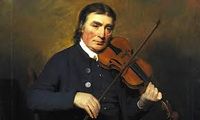Annotation:Niel Gow's Wife (1): Difference between revisions
No edit summary |
No edit summary |
||
| Line 9: | Line 9: | ||
<br> | <br> | ||
<br> | <br> | ||
See '''The Northern Fiddler''' (1979), pp. 81 (bottom tune, and untitled highland) and 194; the latter an untitled strathspey from the playing of Danny O’Donnell. Donegal fiddler O’Donnell recorded the tune in the 78 RPM era, last in a set of three Highlands (preceded by “[[Polly Put the Kettle On (1)]]” and “[[Bundoran Highland (The)]]”). He called his set “[[The Thistle and Shamrock | The Thistle and Shamrock]]” (symbolic of Scotland and Ireland). “[[Watchmaker (The)]]” is a related melody. “[[Niel | See '''The Northern Fiddler''' (1979), pp. 81 (bottom tune, and untitled highland) and 194; the latter an untitled strathspey from the playing of Danny O’Donnell. Donegal fiddler O’Donnell recorded the tune in the 78 RPM era, last in a set of three Highlands (preceded by “[[Polly Put the Kettle On (1)]]” and “[[Bundoran Highland (The)]]”). He called his set “[[The Thistle and Shamrock | The Thistle and Shamrock]]” (symbolic of Scotland and Ireland). “[[Watchmaker (The)]]” is a related melody. “[[Niel Gow's Second Wife (1)]]” appears in the music manuscript copybook of John Burks, dated 1821, who may have been from the north of England (photocopy in ed. possession). It is a rather simplified form of the original strathspey, which retains only some of the characteristic dotted rhythms and 'Scots Snap.' | ||
<br> | <br> | ||
<br> | <br> | ||
Revision as of 03:08, 13 August 2015
Back to Niel Gow's Wife (1)
NIEL GOW'S WIFE [1]. AKA and see "Athole Brose," "Loch Erroch Side,” "Mr. MacDonald of Staffa's Strathspey," "Niel Gow's Second Wife (1)," “Watchmaker (The).” Scottish, Strathspey. G Minor (Athole, Cole, Kerr, Skye, Surenne): A Minor (Williamson). Standard tuning (fiddle). AB (Surenne): AAB (Athole, Cole, Gow, Kerr, Skye): AA'BB (Williamson).

Under the title "Mr. MacDonald of Staffa's Strathspey," the tune is earliest credited to Daniel McLaren of Edinburgh, a native of Taymouth, Perthshire, who published it in 1794 (unfortunately, little is known of him). Gow and sons published the tune as “Niel Gow’s Wife” in their Complete Repository, Book 2 (1802) with composer credits to Inver, Perthshire, fiddler-composer biography:Niel Gow (1727-1807). Still later, in MacDonald’s Skye Collection (1887), it is credited to biography:Duncan MacIntyre. The title has been altered to insert the word “Second” to “Niel Gow’s Wife” to accommodate the apocryphal story of his fiddle being the famous fiddler-composer’s ‘second wife’ in his affections. Niel did, however, have two wives, the first of whom, Margaret Wiseman, bore him five sons; his second, Margaret Urquhart, had no children. The association of instrument and intimate bond has been made with other fiddlers as well, and stems from the old saying that the minstrel’s ‘second wife’ was his harp. Donal Hickey, in his 1999 book on Sliabh Luachra musicians Stone Mad for Music, writes: “Pádraig (O’Keeffe) {1887-1963} remained single and he used to call the fiddle ‘the missus’, declaring that it gave no bit of trouble at all. ‘Just one stroke across the belly and she purrs’, he would say.”The tune is played in County Donegal as a highland and is associated with the playing of Danny O’Donnell, James Byrne and John Doherty.
See The Northern Fiddler (1979), pp. 81 (bottom tune, and untitled highland) and 194; the latter an untitled strathspey from the playing of Danny O’Donnell. Donegal fiddler O’Donnell recorded the tune in the 78 RPM era, last in a set of three Highlands (preceded by “Polly Put the Kettle On (1)” and “Bundoran Highland (The)”). He called his set “ The Thistle and Shamrock” (symbolic of Scotland and Ireland). “Watchmaker (The)” is a related melody. “Niel Gow's Second Wife (1)” appears in the music manuscript copybook of John Burks, dated 1821, who may have been from the north of England (photocopy in ed. possession). It is a rather simplified form of the original strathspey, which retains only some of the characteristic dotted rhythms and 'Scots Snap.'
Source for notated version:
Printed sources: Carlin (The Gow Collection), 1986; No. 446. Cole (1000 Fiddle Tunes), 1940; p. 126. Feldman & O’Doherty (Northern Fiddler), 1979; pp. 81c (appears as untitled Highland) & 194 (appears as untitled strathspey). Gow (Complete Repository, Book 2), 1802; p. 13. Honeyman (Strathspey, Reel and Hornpipe Tutor), 1898; p. 29 (appears as "Neil Gow's Second Wife"). Kerr (Merry Melodies, vol. 1), c. 1875; Set 21, No. 1, p. 13. MacDonald (The Skye Collection), 1887; p. 123. Ryan’s Mammoth Collection, 1883; p. 165. James Stewart-Robertson (The Athole Collection), 1884; p. 186. Surenne (Dance Music of Scotland), 1852; pp. 34-35. Williamson (English, Welsh, Scottish and Irish Fiddle Tunes), 1976; p. 60.
Recorded sources: Compass Records 7 4446 2,Oisíin McAuley – “From the Hills of Donegal” (2007).
